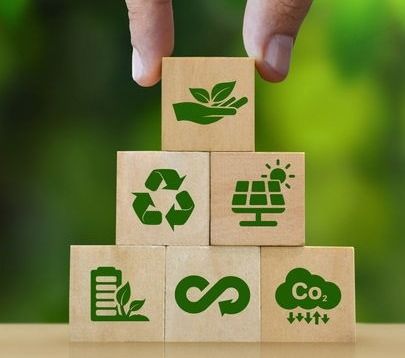Green Customs in Action Webinar - October 2025

On 16 October 2025, the CCES Community hosted a webinar entitled Green Customs in Action which aimed to provide a snapshot on progress associated with WCO Green Customs Action Plan including implementation of multilateral environmental agreements and efforts to green operations and value chains.
The panelists included:
- Hong Nguyen, Lecturer, Hanoi Finance and Banking University (FBU) and Centre for Customs and Excise Studies (CCES).
- Jason Blackman, Global Head of Customs Compliance, DHL Supply Chain
The key take-aways are outlined below.
1. There is still limited awareness of the comprehensive Green Customs agenda.
The WCO’s Green Customs Action Plan 2022-2025 outlines a broad suite of objectives. In addition to the work of protecting the environment and facilitating green trade (“doing”) and fostering innovative thinking and measures with regards to sustainability (“innovating”), there is a “being” dimension which calls on members to improve the environmental performance of their operations and value chains.
Through initiatives like the Greening HS, Customs Enforcement Handbook on Circular Economy, and the SMART Customs Project, the WCO is helping to support members fulfil environmental obligations and enhance sustainability performance. The awareness of Green Customs as well as the uptake and pace of rollout of green customs initiatives varies significantly across members. To address this gap, customs administrations and private sector partners can drive education and advocacy initiatives. For example, DHL’s Cross-Border Entrepreneurial Program could be scaled to include workshops for customs officers, promoting tools like the Green Customs Initiative and SMART Customs Project. Public-private communication campaigns can further raise awareness of green customs benefits, particularly in regions with lower adoption.
2. Strategic intent without operational flexibility limits compliance.
While Multilateral Environmental Agreements (MEAs) often come with a legal framework and implementation strategy, compliance procedures are often rigid and not well adapted to the local context, hindering effective execution. Limited workforce capacity further constrains administrations’ ability to facilitate compliance.
For example, Vietnam Customs is still working on developing criteria to distinguish hazardous from non-hazardous waste and does not currently have a workable risk management database to support officers when it comes to managing plastics and hazardous waste. To overcome these challenges, customs can adopt flexible, technology-driven solutions. Collaborative pilots between customs and private sector partners can test these solutions, ensuring adaptability to diverse regulatory environments.
3. Environmental regulation is a core customs function.
Bilateral and multilateral trade agreements are increasingly linking market access to sustainability, while mechanisms like the Carbon Border Adjustment Mechanism (CBAM) are broadening to include more sectors. To stay ahead, customs must embed transparency and traceability across supply chains and provide visible/real-time data on origin of goods. The key is in establishing systems that allow customs to identify quickly and effectively the compliant from the non-compliant. Fast or green lanes have the knock-on effect of reducing vehicle idle time and therefore emissions at the border.
Real-time data platforms, such as DHL’s digital customs systems, enable tracking of goods’ origins, supporting CBAM compliance. These systems prioritise compliant shipments for green lanes, reducing delays and emissions, as evidenced by DHL’s Go Green Plus Program, which incentivises low-carbon logistics. Such initiatives demonstrate how customs can align with global sustainability goals, including SDG 13 (Climate Action).
4. Understanding prevailing workforce attitudes and beliefs is key to effective change.
Digitising customs workflows is not just about deploying new technologies or delivering training programs; it requires a deep understanding of organisational culture, specifically the prevailing attitudes, assumptions and experiences of customs officers. Customs administrations have traditionally seen themselves as gatekeepers and revenue collectors which can reinforce practices such as an over-reliance on hard copy printed documentation and make it hard to achieve environmental targets.
Shifting to a sustainability-focused mindset requires targeted change management. Training should focus on technical skills like AI and environmental risk assessment while fostering a cultural shift to view customs as enablers of green trade. DHL’s training through the Cross-Border Entrepreneurial Program offers a model for aligning workforce attitudes with environmental goals, reducing reliance on paper-based processes, and supporting digital workflows.
5. Building cooperation around shared environmental goals is important.
Environmental progress accelerates when partners collaborate to identify shared environmental objectives and co-design solutions that are fit-for-purpose. DHL’s Cross-Border Entrepreneurial Program exemplifies this approach whereby DHL staff work with SME business owners to raise awareness of sustainability opportunities, challenges, and risks in trade and through training and support help business adopt environmentally friendly practices including eco-friendly packaging, and low-carbon transport, and logistics options.
Structured public-private partnerships (PPPs) can further drive innovation, such as developing green corridors or blockchain-based traceability systems. DHL’s collaboration with SMEs and multilateral bodies demonstrates how PPPs can advance sustainable trade practices, aligning with SDG 17 (Partnerships for the Goals).
6. Rethinking workforce capabilities for Green Customs.
Business and environmental objectives must be pursued together. They are not mutually exclusive. However, current leadership and management capabilities may be insufficient to advance the green customs agenda. If customs and logistics providers wish to strengthen their environmental performance, they will need to nurture capabilities such as environmental literacy (e.g. circular economy, carbon accounting), digital literacy (e.g. AI and data analytics), stakeholder engagement (including co-design and co-production), supply chain management, reverse logistics and build knowledge and skills associated with environmental regulation.
Continuous learning programs are essential to keep pace with evolving regulations. DHL’s investment in AI training and stakeholder engagement provides a blueprint for building adaptive, future-ready workforce capabilities, supporting SDG 9 (Industry, Innovation, and Infrastructure).
Links to further information:
- Risks and Challenges of China Customs’ Response to Global Green Trade Barriers | World Customs Journal
- www.worldcustomsjournal.org/article/144232-risks-and-challenges-of-china-customs-response-to-global-green-trade-barriers
- Enhancing the Roles of Vietnam Customs in Fostering the Circular Economy | World Customs Journal
- www.worldcustomsjournal.org/article/136892-enhancing-the-roles-of-vietnam-customs-in-fostering-the-circular-economy
- WCO Green Customs Action Plan 2022-2025 www.wcoomd.org/-/media/wco/public/global/pdf/topics/key-issues/green-customs/gcap-public.pdf
- DHL GoGreen Solutions - Environmentally-Friendly Freight
- www.dhl.com/us-en/home/global-forwarding/products-and-solutions/gogreen-solutions.html
- WCO Smart Customs Project
- www.wcoomd.org/en/topics/facilitation/activities-and-programmes/disruptive-technologies/smart-customs-project.aspx
- WCO Transition to a circular economy and implications for Customs administrations report www.wcoomd.org/-/media/wco/public/global/pdf/topics/research/report/circular-economy-report-en.pdf
- WCO Customs and environmental policies
- www.wcoomd.org/en/topics/customs-and-environmental-policies.aspx